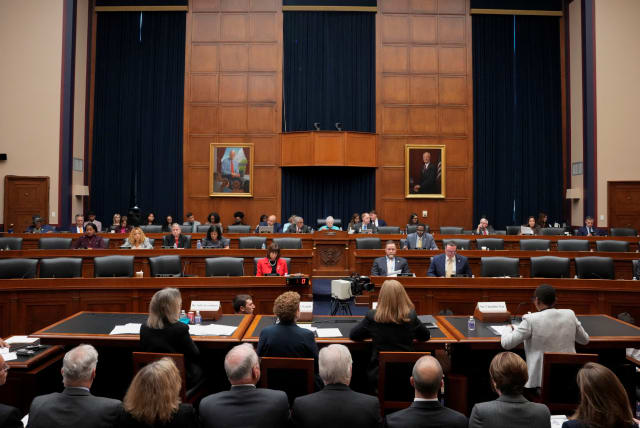Dept. of Education Office of Civil Rights releases guidance on discrimination regulations

The new guidance comes in light of an uptick in Title VI complaints.
NEW YORK – US Department of Education Assistant Secretary for Civil Rights Catherine Lhamon released a “Dear Colleague” letter on Wednesday in response to “recent increases” in Title VI complaints filed with the Office of Civil Rights (OCR).
“To be clear, Title VI’s protections against discrimination based on race, color, and national origin encompass antisemitism and other forms of discrimination when based on shared ancestry or ethnic characteristics,” Lhamon wrote.
The guidance released Wednesday includes “illustrative” examples to help schools carry out “Title VI” requirements but does not create new legal standards.
Hostile environments violate Title VI
All educational institutions that receive federal financing are required to comply with Title VI, the letter said. Title VI does not protect students from discrimination based solely on religion, which OCR said it would refer complaints of discrimination based exclusively on religion to the US Department of Justice which has jurisdiction to respond to certain complaints of religious discrimination in public schools.
The letter identified two legal frameworks that courts and OCR use to determine if schools have engaged in discrimination that violates Title VI – hostile environment and different treatment and starts with a section on First Amendment considerations.
“The fact that harassment may involve conduct that includes speech in a public setting or speech that is also motivated by political or religious beliefs, however, does not relieve a school of its obligation to respond under Title VI as described below, if the harassment creates a hostile environment in school for a student or students,” according to the letter.
The letter said schools have a number of tools for responding to a hostile environment, including tools that do not restrict any rights protected by the First Amendment such as communicating its opposition to stereotypical, derogatory opinions, providing counseling and support for students affected by harassment or take steps to establish a welcoming and respectful school campus.
OCR does not interpret Title VI to require any recipient to abridge any rights protected under the First Amendment, the letter said.
For instance, according to the letter, if students at a public university engage in offensive speech about members of a particular ethnic group and that speech contributes to a hostile environment within an education program about which the university knows or should know, the university “has a legal obligation to address that hostile environment for students in schools.”
“The university may, however, be constrained or limited in how it responds if speech is involved,” according to the letter.
The existence of a hostile environment based on race, color, or national origin that is “created, encouraged, accepted, tolerated or left uncorrected” by a school can constitute discrimination in violation of Title VI.
According to the letter, OCR interprets Title VI to mean the following type of harassment creates a hostile environment: unwelcome conduct based on race, color, or national origin that, based on the totality of circumstances, is subjectively and objectively offensive and is so severe or pervasive that it limits or denies a person’s ability to participate in or benefit from a school’s education program or activity.
The letter said a hostile environment may take the form of a single victim and multiple offenders.
The offensiveness of a particular expression as perceived by some students, standing alone, is not a legally sufficient basis to establish a hostile environment under Title VI.
“OCR evaluates the conduct from the perspective of the student who is allegedly being harassed and from the perspective of a reasonable person in that student’s position, considering all the circumstances,” the letter said.
In order to create a hostile environment, the harassing conduct, which may include speech expression, must be so severe or pervasive that it limits or denies a student’s ability to participate in or benefit from the school’s program or activity.
OCR may find discrimination occurred if there is direct evidence that a school limited or denied educational services, benefits, or opportunities to a student or group of students on the basis of race, color, or national origin.
The letter said speech expressing views regarding a particular country’s policies or practices is protected by the First Amendment and does not necessarily implicate federal civil rights laws.
However, if the conduct that otherwise appears to be based on views about a country’s policies or practices is targeted at or infused with discriminatory comments about persons from or associated with a particular country, that might implicate Title VI, the letter said.
“All students, including students who are or are perceived to be Jewish, Israeli, Muslim, Arab, Sikh, South Asian, Hindu, or Palestinian as well as students who come from, or are perceived to come from, all regions of the world are entitled to a school environment free from discrimination,” according to Lhamon.
She concluded, “Thank you for your commitment to providing educational environments to our nation’s students that are free of race, color, or national origin discrimination and consistent with free speech rights fundamental to our nation’s tradition.”
Jerusalem Post Store
`; document.getElementById("linkPremium").innerHTML = cont; var divWithLink = document.getElementById("premium-link"); if (divWithLink !== null && divWithLink !== 'undefined') { divWithLink.style.border = "solid 1px #cb0f3e"; divWithLink.style.textAlign = "center"; divWithLink.style.marginBottom = "15px"; divWithLink.style.marginTop = "15px"; divWithLink.style.width = "100%"; divWithLink.style.backgroundColor = "#122952"; divWithLink.style.color = "#ffffff"; divWithLink.style.lineHeight = "1.5"; } } (function (v, i) { });

